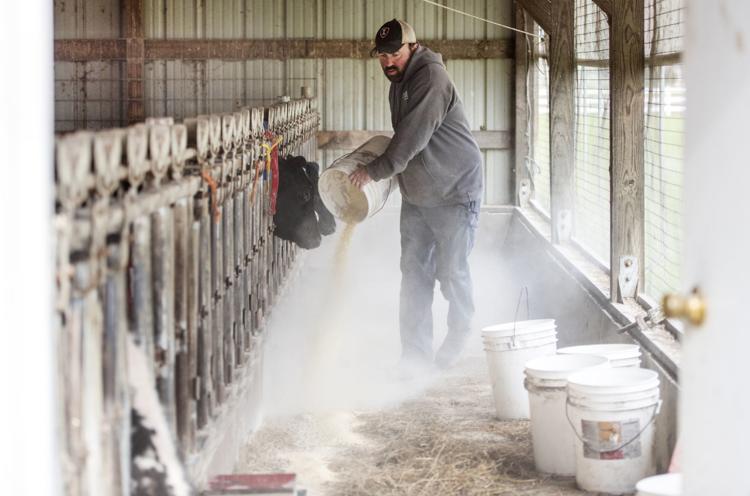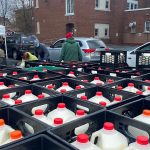
The newspaper and television images of farmers dumping milk, pouring away their livelihood. Consumers feel for those farmers but struggle with what they see as food going to waste.
It’s an old tale with a pandemic twist: The disconnect between agriculture and the general public means that consumers are less likely to understand the difficult choices facing dairy farmers.
Here’s the part of the story that’s easy to understand: With restaurants and schools closed, the processing plants that put milk into tiny cartons for schools or create pizza cheese just don’t need that much milk anymore.
“It’s changed how consumers are shopping for dairy products,” said Sandy Larson, business manager for Larson Acres, a 2,800-cow dairy in the town of Magnolia. “The way they package for schools and restaurants is not how they package for grocery stores. That’s not something that’s easily changed or adapted to.”
Consumers might be buying more milk at the store, but processing plants, just like manufacturing plants, can’t immediately reconfigure their assembly lines from one dairy product to another.
Price history
Dairy farming was in the news even before the pandemic hit. For much of 2018 and for the first quarter of 2019, milk languished below $15 per hundred weight, or 100 pounds of milk. There are about 8.6 pounds of milk in a gallon, according the USDA.
That $15 represents the Class III or base price. Then farmers get premiums for high butterfat content and other quality measures.
The cost of production varies from farm to farm, but it averages about $17 per hundred weight. For much of 2018 and the first quarter of 2019, milk prices languished below the $15 mark, dropping as low as $13.42. But about a year ago, prices began to go up. In December, they reached $20.18 and then started to drop. When the pandemic hit, they plunged.
On April 1, the price was $16.25 per hundred weight, already below the cost of production. By April 24, it had dropped to $13.20. The Chicago Board of Trade’s predicts milk prices of about $10.20 in May and $11.95 in June.
Extra pressures
Steve Case and his wife, Liz, have been milking cows near Footville for the past 48 years. They’ve been joined by their son, Craig, and their grandson, Tyler.
Case knows, as all dairy farmers do, that prices fluctuate, and they have to be prepared for those times. No dairy farmer is going to bank on continued good—or even rising—prices.
The Cases sell their milk to Decatur Dairy, and Steve Case is on the board of a co-op that sells to the dairy.
“We (the board) voted that starting May 1, we have cut our production by 10 percent,” Case said. “The dairy just cannot handle that much milk.”
The Cases milk about 145 cows twice a day. They produce 12,250 pounds of milk each day and are proud to have 37 cows who produce more than 100 pounds a day, well above the 80- to 90-pound daily average. A handful of their cows produce 142 pounds a day, a tribute to genetics and management.
Now they have to reduce that 12,250 pounds a day to about 11,100 a day.
“It’s not like you can turn that milk valve off,” Case said.
Case hopes it won’t mean dumping milk, but he knows it will mean other, equally grim, measures.
He has been culling the herd, taking animals to Monroe Equity, where they are sold for meat production. But that market has taken a dive, too. With meat processing plants slowing down or closing due to COVID-19, the demand isn’t there. He usually gets between $700 and $800 per cow. Now he gets between $300 and $400. The animals sell per pound, and there’s only a handful of buyers. They can offer whatever price per pound they want, and he has to take it.
He can also change his feeding system, giving his animals less protein in their total mix ration. The animals won’t go hungry, but they will produce less milk.
“So now I’ve got to take good stuff away from that cow so she can drop 30 or 40 pounds of production?” Case said. “It’s hard to do that.”
Dairy farm periodicals and websites are now full of articles like this one from Cornell University’s College of Ag and Life Sciences: “Diet and management considerations for emergencies: Reducing milk flow without harming cows and future production.”
A cow who gets her ration changed so she gives less milk during an emergency won’t immediately—if ever—return to peak production when her diet goes back to what it used to be.
So that’s another loss.
In addition, the family will be selling less than their usual volume, so they will be getting less money for less milk, a double hit.
Case plans to feed some of the excess milk to his calves. Usually, milk replacement is used because it is easier to manage. But this will save money and put the extra milk to good use.
Despite all of the economic trials, Case loves his job. He said he didn’t want a story designed to “make people feel sorry for dairy farmers.”
He just wants the facts out there so people will understand.
Understanding dairy
Larson recently announced on Facebook that her family had been through a difficult week. They had no choice but to dump milk, as their processing plant could no longer handle the volume.
Some people suggested that they donate it to food pantries or give it to those in need.
“I can’t do that,” Larson said. “I can’t pasteurize the milk on the farm.”
Pasteurizing, a process that kills harmful bacteria that can be found in raw milk, is done at the dairy plant. In Wisconsin, the sale of raw milk is prohibited.
Larson, who is a fifth-generation dairy farmer, sounds mournful when she talks about the whole situation.
“It’s hard. I watch the cows being milked every day and I know that milk is not going anywhere,” she said. “And my employees are sad.”
Larson also hates to see the milk just thrown away and wishes she could donate it.
“It’s just not that simple,” Larson said. “I hope people understand that.”

























